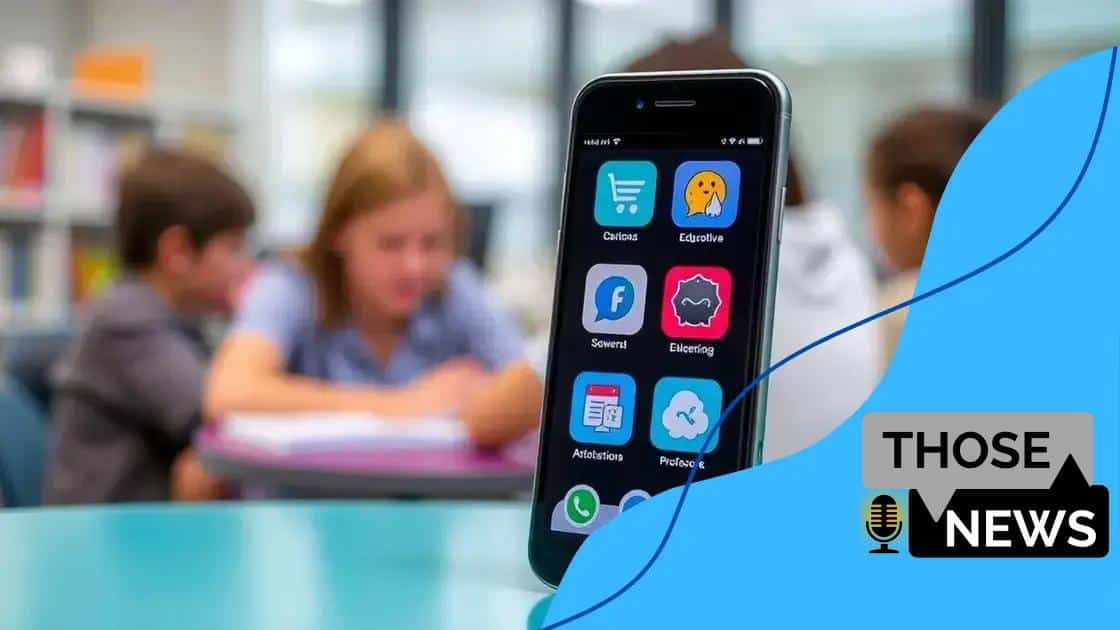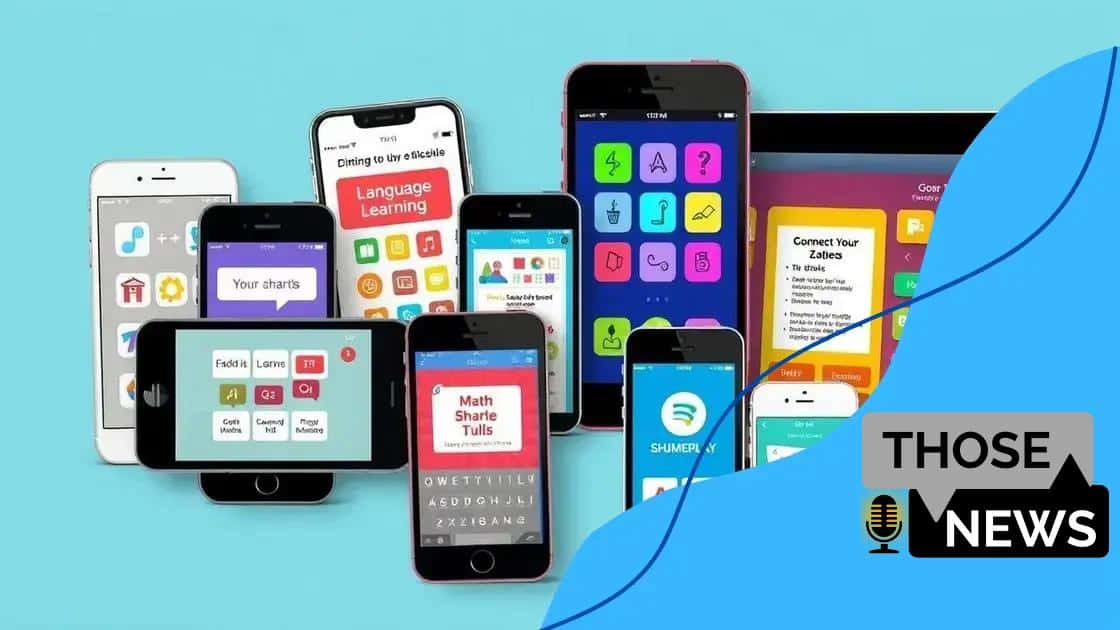Mobile learning applications: revolutionizing education on-the-go

Mobile learning applications offer flexible, engaging educational experiences that utilize features like AI customization, augmented reality, and microlearning to enhance user learning outcomes efficiently.
Mobile learning applications are transforming the educational landscape, allowing learners to access resources anytime and anywhere. Have you ever wondered how this could impact your study habits and achievements?
What are mobile learning applications?
Mobile learning applications are tools designed to enhance educational experiences through portable devices. They allow users to learn anytime and anywhere, making education more flexible and accessible.
These applications can include various features such as interactive quizzes, video lectures, and discussion forums. With so many options available, they cater to different learning styles and preferences.
Key Features of Mobile Learning Applications
Some key features that make these applications effective include:
- Accessibility: Learners can access materials from anywhere.
- Interactivity: Engaging elements help maintain interest.
- Customization: Users can tailor their learning paths.
- Instant Feedback: Quizzes provide immediate responses for better learning.
Mobile learning applications are designed to accommodate various educational needs. They can support traditional subjects like mathematics and science, or more niche areas such as language learning and professional development.
Moreover, they often incorporate gamification elements, which turn learning into fun experiences. This helps motivate users to engage more deeply with the content.
Different Types of Mobile Learning Applications
There are several types of mobile learning applications available:
- Learning Management Systems (LMS): Platforms for managing and delivering training.
- Language Learning Apps: Programs focused specifically on teaching new languages.
- Content Creation Apps: Tools that allow users to create educational content.
As technology evolves, so do mobile learning applications. They are becoming increasingly sophisticated, using features like artificial intelligence to customize learning experiences even further. This means that education is not only more accessible but also more efficient than ever before. In today’s fast-paced world, staying updated with the latest trends in mobile learning is crucial for learners and educators alike.
Benefits of using mobile learning applications
Using mobile learning applications offers numerous benefits that make education more effective and enjoyable. These tools are accessible on various devices, allowing learners to study at their own pace and on their own schedule.
One major advantage is flexibility. Learners can engage with the material anytime and anywhere, whether they’re at home, on the bus, or in a coffee shop. This accessibility helps integrate learning into the daily routine.
Enhanced Engagement
Another benefit is the ability to create engaging content. Mobile applications often include multimedia elements like videos, animations, and interactive quizzes. These features help keep users interested and motivated throughout their learning journey.
- Gamification: Many apps incorporate game-like aspects, making learning fun and competitive.
- Instant Feedback: Users receive immediate results from quizzes, helping them understand their strengths and weaknesses.
- Variety of Resources: Learners can access a wide range of materials, from e-books to podcasts, enhancing their educational experience.
Moreover, mobile learning applications support different learning styles. Whether a user prefers visual aids, auditory materials, or hands-on activities, mobile apps can cater to their unique preferences.
Collaboration is also enhanced through these applications. Many platforms allow students to connect with peers and educators, fostering a sense of community. This collaboration can lead to richer discussions and a deeper understanding of the material.
Cost-Effectiveness
Cost-efficiency is another important aspect. Many mobile learning applications are available for free or at a low cost, making education accessible to a wider audience. This is particularly beneficial for those who may not have the means to afford traditional education.
In summary, the use of mobile learning applications significantly transforms how we engage with education. The combination of convenience, engagement, and cost-effectiveness opens new doors for learners everywhere, leading to better educational outcomes.
Popular mobile learning applications in 2023

In 2023, several mobile learning applications are leading the way in educational technology. These apps provide a range of features that cater to different learning needs, making education more accessible and engaging.
One of the most popular apps is Duolingo. It focuses on language learning through fun exercises and gamification. Users can learn over 30 languages, practicing vocabulary, grammar, and conversation skills.
Key Features of Popular Learning Apps
Many top apps share several important features that enhance the learning experience:
- Interactive Content: Engaging lessons that include videos, quizzes, and exercises.
- Progress Tracking: Users can see their improvements over time, which motivates them to continue learning.
- Community Support: Many apps have forums where learners can connect and help each other.
- Offline Access: Some applications allow users to download content for use without an internet connection.
Khan Academy is another remarkable app featured in 2023. It offers a vast library of instructional videos and practice exercises across various subjects, including math, science, and the arts. The platform is well-known for its comprehensive resources that cater to learners of all ages.
Another noteworthy app is Quizlet. This platform allows users to create flashcards and quizzes, making review sessions more efficient. The collaborative features enable students to share their study sets with classmates, promoting teamwork and collective learning.
Innovations in Mobile Learning
Apps like Coursera and edX are changing the way higher education is delivered. They provide access to courses from top universities around the world, often for free or at a fraction of the cost of traditional education. This opens doors for learners who may not have had the opportunity otherwise.
Finally, Prodigy Math is gaining traction among younger users. The app combines an interactive game with a math curriculum, making math fun and engaging for children. Its adaptive learning features ensure that learners progress at their own pace.
As technology continues to evolve, these mobile learning applications will likely keep expanding, offering even more resources and features. Staying informed about these tools can help users maximize their learning potential in 2023 and beyond.
How to choose the right mobile learning application
Choosing the right mobile learning application can greatly impact your educational experience. With so many options available, it’s important to consider your personal learning needs and preferences.
First, think about what subject you want to learn. Different apps specialize in different areas, such as language learning, math, or science. Identifying your goals will help you narrow down your choices.
Assessing Features
When evaluating apps, consider the features that will enhance your learning. Look for applications that offer:
- Interactivity: Engaging content, such as quizzes and videos, can make learning more enjoyable.
- Customization: The ability to tailor your learning path to fit your style can greatly improve your focus.
- Progress Tracking: Features that show your advancement can motivate you to keep going and achieve your goals.
- Offline Access: This is particularly useful if you want to study on the go without needing an internet connection.
Another important factor is the user interface. A clean and intuitive design makes it easier to navigate the app and find what you need. Read reviews and watch tutorials to gauge the app’s usability.
Considering Cost and Compatibility
Price is also a key consideration. Many mobile learning applications are free or offer a free trial. However, some may require a subscription or one-time payment. Evaluate whether the app’s pricing aligns with your budget. Additionally, check compatibility with your device. Ensure the app works on your smartphone, tablet, or both.
Lastly, don’t hesitate to test a few apps before making a decision. Most of them allow you to explore basic features for free. This way, you can find out which one truly resonates with your learning style. As you begin your journey, remember that the best tool is one that not only meets your needs but also motivates you to learn consistently.
Future trends in mobile learning applications
The future of mobile learning applications is bright and full of exciting possibilities. With rapid advancements in technology, these apps are evolving to meet the changing needs of learners around the world.
One major trend is the integration of artificial intelligence (AI). AI can personalize learning experiences by adapting content to match individual user preferences and performance levels. This means learners will receive tailored lessons that help them progress more efficiently.
Increased Use of Augmented Reality
Another prominent trend is the use of augmented reality (AR) in educational apps. AR technology allows users to interact with digital content in real-world environments. This can make complex subjects, such as science or history, more engaging by providing immersive experiences.
- Interactive Visualizations: AR can turn traditional lessons into interactive exploration.
- Real-World Applications: Users can see how concepts apply in real life, enhancing understanding.
- Enhanced Memorization: Gamified learning through AR can improve retention of information.
Mobile learning applications are also likely to focus more on social learning. Features that encourage collaboration among peers, such as discussion boards or group projects, will foster a sense of community among learners. This is especially important as many students prefer studying in groups.
Focus on Microlearning
Another significant trend is microlearning, which involves delivering content in small, easily digestible units. This approach is effective for on-the-go learners who may only have a few minutes to study at a time. Microlearning allows users to fit learning into their busy schedules, making education more accessible.
Additionally, applications will increasingly incorporate more multimedia elements—like videos, podcasts, and interactive graphs—to cater to various learning styles. This diversification helps maintain users’ interest and promotes better comprehension of the material.
As the digital landscape continues to evolve, the capabilities of mobile learning applications will expand. Staying updated with these trends will help learners take advantage of new features and tools designed to enhance their educational experiences.
FAQ – Frequently Asked Questions about Mobile Learning Applications
What are mobile learning applications?
Mobile learning applications are educational tools designed for smartphones and tablets, allowing users to learn anytime and anywhere.
How can mobile learning applications enhance my learning experience?
These apps often include interactive content, personalized learning paths, and various resources to keep users engaged and motivated.
Are mobile learning applications suitable for all ages?
Yes, there are mobile learning applications tailored for various age groups, from children to adults, catering to different learning needs.
How do I choose the best mobile learning application for my needs?
Consider your learning goals, preferred subjects, app features, and user reviews to find the right application for you.





